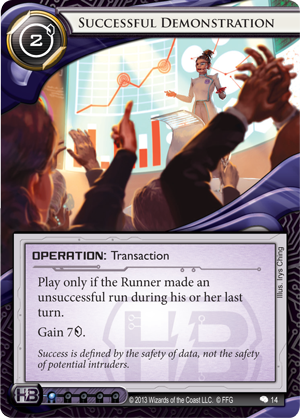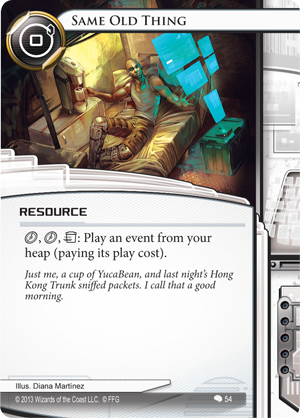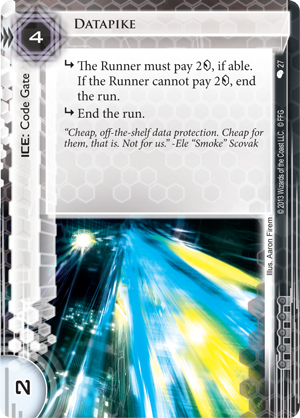Something BorrowedA Preview of Creation and Control by Guest Writer El-ad David Amir
“These runners aren’t hermits who live in seclusion, isolated from the rest of the world. They have contacts throughout the underworld and even within legitimate organizations. Even worse, they may be individualists, but they sometimes share with each other; they can share programs, they can share tricks, and they can share contacts.”
–Michael Muhama, NBN security analyst
Creation and Control is coming soon. In our last two previews, we reviewed the upgraded bioroids that Haas-Bioroid hopes will secure their servers and raise their profit margin, and we met the three eccentric, new Shapers getting ready to make their impact upon the cyberstruggles of Android: Netrunner.
Today, guest writer El-ad David Amir explores what the expansion has to offer fans of the game’s other factions.
El-ad David Amir on Shared Technology and Common Contacts
Creation and Control focuses on the struggles between the industrious Haas-Bioroid and the ingenious runners known as Shapers. However, they’re not the only factions who will be able to integrate this expansion’s latest innovations into their own schemes. A wide range of new software becomes accessible, and several shady new contacts will offer their services to any customer with a heavy purse. Whoever you are, whatever you do, you are guaranteed to find new treasures in Creation and Control.
The deck-building rules for Android: Netrunner allow players to include almost any card in their decks…but only up to a point. The game’s influence mechanic limits the number of out-of-faction cards you can build into your deck, which necessitates frugality. But a number of low-influence cards can greatly supplement a deck’s economy.
Successful Demonstration (Creation and Control, 14) is a transaction operation that offers a high net gain of five credits. However, it can only be played if the runner made an unsuccessful run, which means it might have limited value later in the game after the Runner has had a chance to build up his rig. Still, there are some Corps that might gladly incorporate Successful Demonstration into their plans. One is Jinteki; they can force the runner into unsuccessful runs with cards such as Nisei Mk II (Core Set, 68), and they can benefit more than most corps from new, effective economy cards. Another is Weyland Consortium: Building a Better World (Core Set, 93), which may be willing to wait a couple of turns to trigger a powerful transaction that, in turn, triggers the identity’s bonus credit.


Runners are going to enjoy their own spoils with Professional Contacts (Creation and Control, 49), a variant of the iconic Magnum Opus (Core Set, 44). Professional Contacts exchanges the raw credit acceleration of Magnum Opus with a more varied approach; instead of providing two credits, Professional Contacts yields one credit and one card. In a Shaper deck that can run three copies each of Diesel (Core Set, 34) and Quality Time (Humanity’s Shadow, 87), the tradeoff is rarely justified. In the eyes of an Anarch, on the other hand, Professional Contracts shines as Anarchs often seek to gain credits while digging quickly through their decks. It also saves them the precious memory units they would have to spend on Magnum Opus!
 Another use of low-influence cards is to import hallmark elements of one faction into a deck for another. As an example, Feedback Filter (Creation and Control, 37) is a defensive card that prevents both net damage and brain damage, two effects typically exclusive to Shapers. It is a versatile emergency button that provides safety as the Runner rushes into an unexplored server, and it can mitigate the effects of many different ambushes, such as Project Junebug (Core Set, 69), Edge of World (Cyber Exodus, 53), and Snare! (Core Set, 70).
Another use of low-influence cards is to import hallmark elements of one faction into a deck for another. As an example, Feedback Filter (Creation and Control, 37) is a defensive card that prevents both net damage and brain damage, two effects typically exclusive to Shapers. It is a versatile emergency button that provides safety as the Runner rushes into an unexplored server, and it can mitigate the effects of many different ambushes, such as Project Junebug (Core Set, 69), Edge of World (Cyber Exodus, 53), and Snare! (Core Set, 70).
Minelayer (Creation and Control, 18) is a cheap piece of ice that can help any corporation build unsurpassable towers of ice, like those Haas-Bioroid often builds. Its sole subroutine installs an additional ice on the same server, without requiring an installation cost. A runner who wants to save a few credits and ignores Minelayer now risks facing a well-defended fortress later, and Minelayer’s ability to mitigate installation costs combines well with economy-based ice, such as NBN’s Pop-up Window (Cyber Exodus, 56). While he does not harm the runner directly, Director Haas’s son, Thomas Haas (Creation and Control, 12), merges the Haas-Bioroid flavor with that of an ambush strategy. Thomas Haas can lure a Runner to a phantom server where he’ll waste his precious resources, and he can do it while doubling as potential protection from Account Siphon (Core Set, 18) or Vamp (Trace Amount, 21).
Imitation Is the Sincerest Form of Flattery
The potency of a number of popular cards has led to their widespread adoption across factions. Creation and Control introduces several neutral cards with similar abilities that may serve as excellent replacements and free up precious influence.
For example, Same Old Thing (Creation and Control, 54) is a runner resource that pulls events out of the heap, an ability that previously only appeared on the Anarch card, Déjà Vu (Core Set, 2). It is weaker than its Anarch predecessor due to the fact that it’s limited to events; however, for an aggressive Criminal whose goal is to recycle events, Same Old Thing is a bargain.


On the Corp side, Datapike (Creation and Control, 27) is a neutral ice that resembles Tollbooth (Core Set, 90), a common NBN ice. Both are code gates, both have an “End the run” subroutine, and both can really tax the runner’s funds. Most runners will be forced to shell out the credits when they first encounter Datapike, and though it’s weaker than its big brother, it is significantly cheaper to rez.
Gila Hands Arcology (Creation and Control, 23) is another interesting card. This neutral agenda takes an ability previously exclusive to Weyland Consortium and makes it public; it’s an agenda that’s not only worth points but has the ability to accelerate a Corp’s credits. The mechanic runs parallel to Weyland’s Government Contracts (A Study in Static, 77), although the ratio isn’t quite as efficient. That said, it’s much easier for a Corp to actually score Gila Hands Arcology, especially since it can be done in a single turn with the aid of another card, such as SanSan City Grid (Core Set, 92). Because the Corp frequently gains credits through one-time operations and assets that can be trashed by the Runner, an early Gila Hands Arcology could radically alter the flow of the game. Once scored, Gila Hands Arcology combines the best of both worlds, being both a constant and reliable source of credits.
A Whole New Paradigm
All Android: Netrunner cards prior to Creation and Control fit into one of two categories: faction cards that cost influence and neutral cards that do not. But what if a card was so new, so transformative, that it wouldn’t be fair to make it influence free or keep it to just one faction?
Enter…The Source (Creation and Control, 55).
 For the bargain price of two credits, The Source allows the Runner to go straight to the heart of the Corp’s game, instantly slowing them down. It can single-handedly earn the Runner an additional turn to steal an agenda. For example, if the Corp installs a five-cost agenda and advances it twice, The Source prevents the Corp from scoring that agenda on the following turn. Still, The Source’s impact on the game can be much more subtle and much more sinister than that. Oftentimes, the Corp will carefully time the installation and advancement of a card in order to reduce the Runner’s chances of accessing it. Fast-advance decks take this concept to the extreme by including acceleration cards like Biotic Labor (Core Set, 59) and low-cost agendas: a combination that focuses on the Corp’s ability to install and score its agendas on a single turn each, denying the Runner of the opportunity to try and steal them from a remote server. By increasing the advancement requirement by one, The Source forces a fast-advance Corp back into remote servers and a dangerous game of chicken. In exchange for this far-reaching impact, the card comes with an influence cost of two that every runner faction will have to pay if it wants to receive The Source’s services.
For the bargain price of two credits, The Source allows the Runner to go straight to the heart of the Corp’s game, instantly slowing them down. It can single-handedly earn the Runner an additional turn to steal an agenda. For example, if the Corp installs a five-cost agenda and advances it twice, The Source prevents the Corp from scoring that agenda on the following turn. Still, The Source’s impact on the game can be much more subtle and much more sinister than that. Oftentimes, the Corp will carefully time the installation and advancement of a card in order to reduce the Runner’s chances of accessing it. Fast-advance decks take this concept to the extreme by including acceleration cards like Biotic Labor (Core Set, 59) and low-cost agendas: a combination that focuses on the Corp’s ability to install and score its agendas on a single turn each, denying the Runner of the opportunity to try and steal them from a remote server. By increasing the advancement requirement by one, The Source forces a fast-advance Corp back into remote servers and a dangerous game of chicken. In exchange for this far-reaching impact, the card comes with an influence cost of two that every runner faction will have to pay if it wants to receive The Source’s services.
Soon, any faction will have its chance to charm The Professor’s contacts, bribe Director Haas’s son, or play The Source’s dangerous game. While Creation and Control is dominated by Haas-Bioroid and the Shapers, the flexibility of Android: Netrunner ensures that all factions will enjoy the spoils of the upcoming expansion.
Who will write the future?
Thanks, El-ad!
Creation and Control will soon add new fuel to the high-stakes cyberstruggles of Android: Netrunner, and there’s plenty of new tricks coming for all of the game’s factions!
...
Source:
Something Borrowed

